Local knowledge, volunteers fuel search and rescue operations in the North

Canada’s coastlines offer some of the world’s most difficult environmental conditions for maritime search and rescue operations. The unforgiving North presents unique challenges — the weather can be fierce and brutal, the Canadian Coast Guard has limited resources available to cover vast territory and military air assets must travel from bases in southern Ontario and the East Coast if they are called in to help.
But determined groups of locals — many of them volunteers — are coming up with innovative, made-in-the-North solutions to keep people safe.
Members of the Senate Committee on Fisheries and Oceans continued their in-depth study of maritime search and rescue operations with a fact-finding mission to Iqaluit, Nunavut and Kuujjuaq, Que. in October 2018. Here’s a glimpse of what they found.
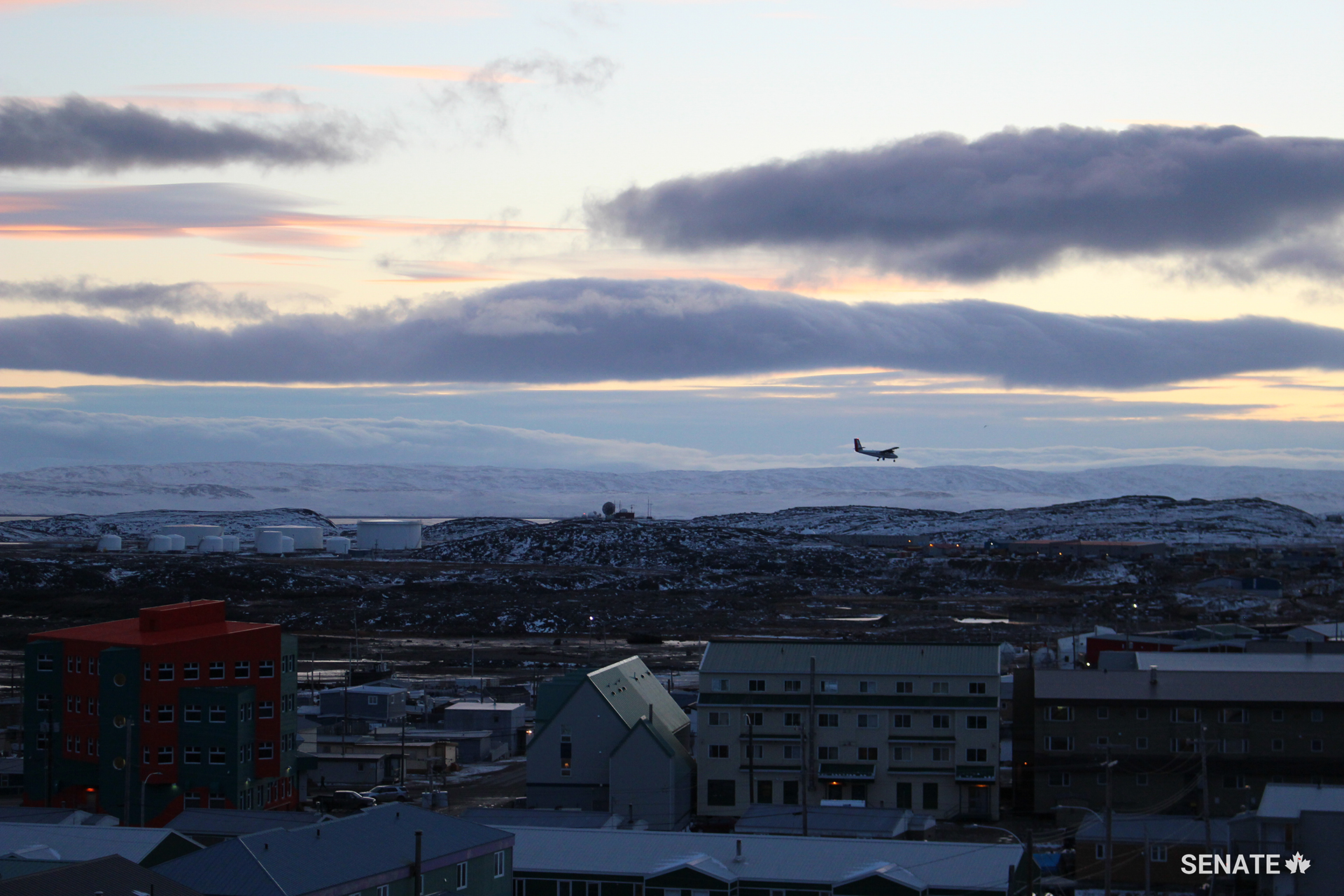 A small aircraft descends toward the airport in Iqaluit as the sun sets over Frobisher Bay. Air resources are difficult to come by in the North. Some Canadian Coast Guard icebreakers have light helicopters that can help with a search but not a rescue, and military resources are all based out of southern Canada, hours away.
A small aircraft descends toward the airport in Iqaluit as the sun sets over Frobisher Bay. Air resources are difficult to come by in the North. Some Canadian Coast Guard icebreakers have light helicopters that can help with a search but not a rescue, and military resources are all based out of southern Canada, hours away.
Michael Chappell, Zone Commander for the Civil Air Search and Rescue Association — a volunteer, non-profit group better known by its acronym, CASARA — told the committee his group builds relationships with private companies that have aircraft in the North so search operations can start more quickly.
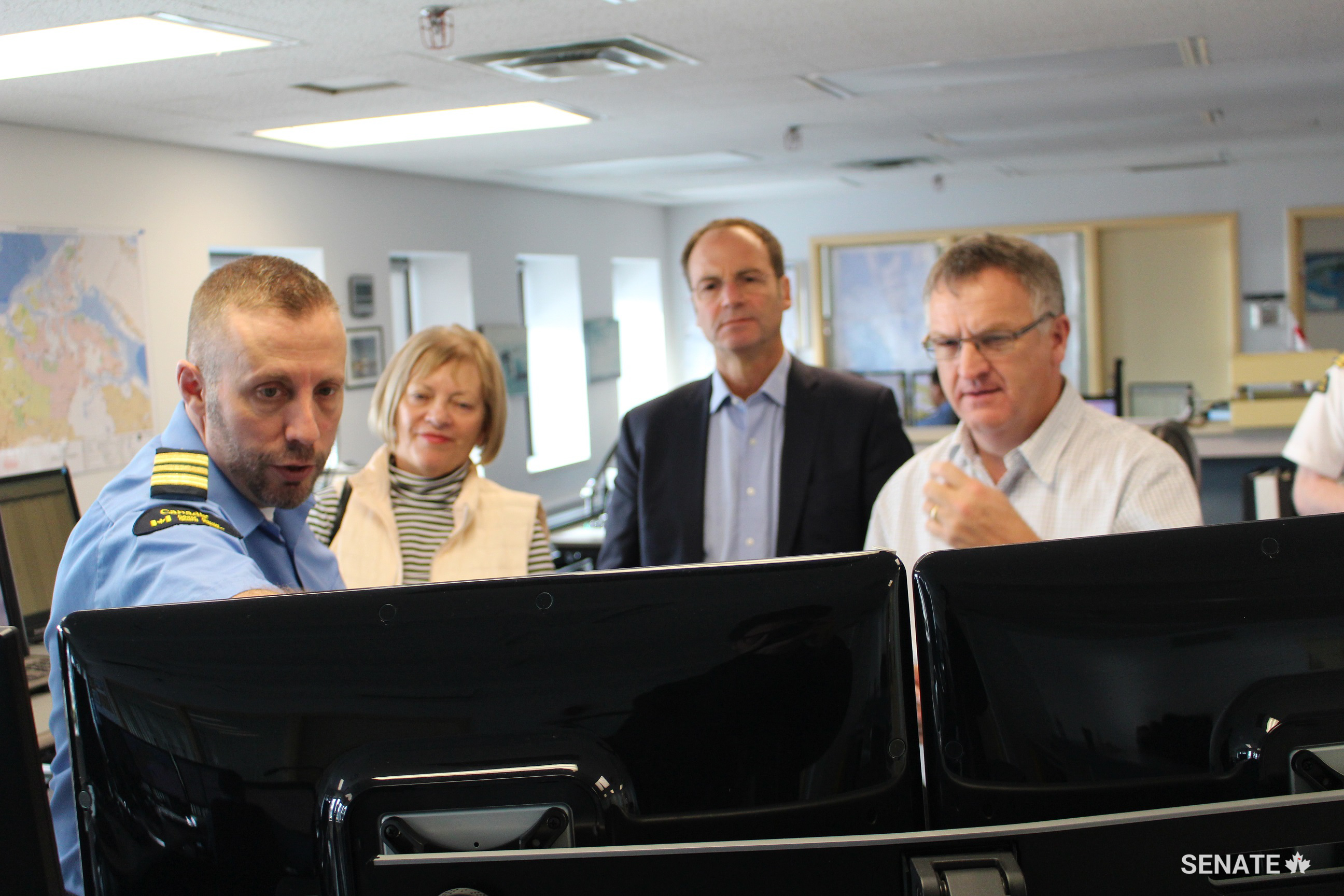 From right, committee chair Senator Fabian Manning, deputy chair Senator Marc Gold and Senator Nancy Hartling follow Louis Robert’s explanation of software used to monitor marine traffic in the Arctic at the Canadian Coast Guard’s Iqaluit communications facility. The coast guard is expecting a steady increase of marine traffic through the treacherous Northwest Passage as the North continues to warm.
From right, committee chair Senator Fabian Manning, deputy chair Senator Marc Gold and Senator Nancy Hartling follow Louis Robert’s explanation of software used to monitor marine traffic in the Arctic at the Canadian Coast Guard’s Iqaluit communications facility. The coast guard is expecting a steady increase of marine traffic through the treacherous Northwest Passage as the North continues to warm.
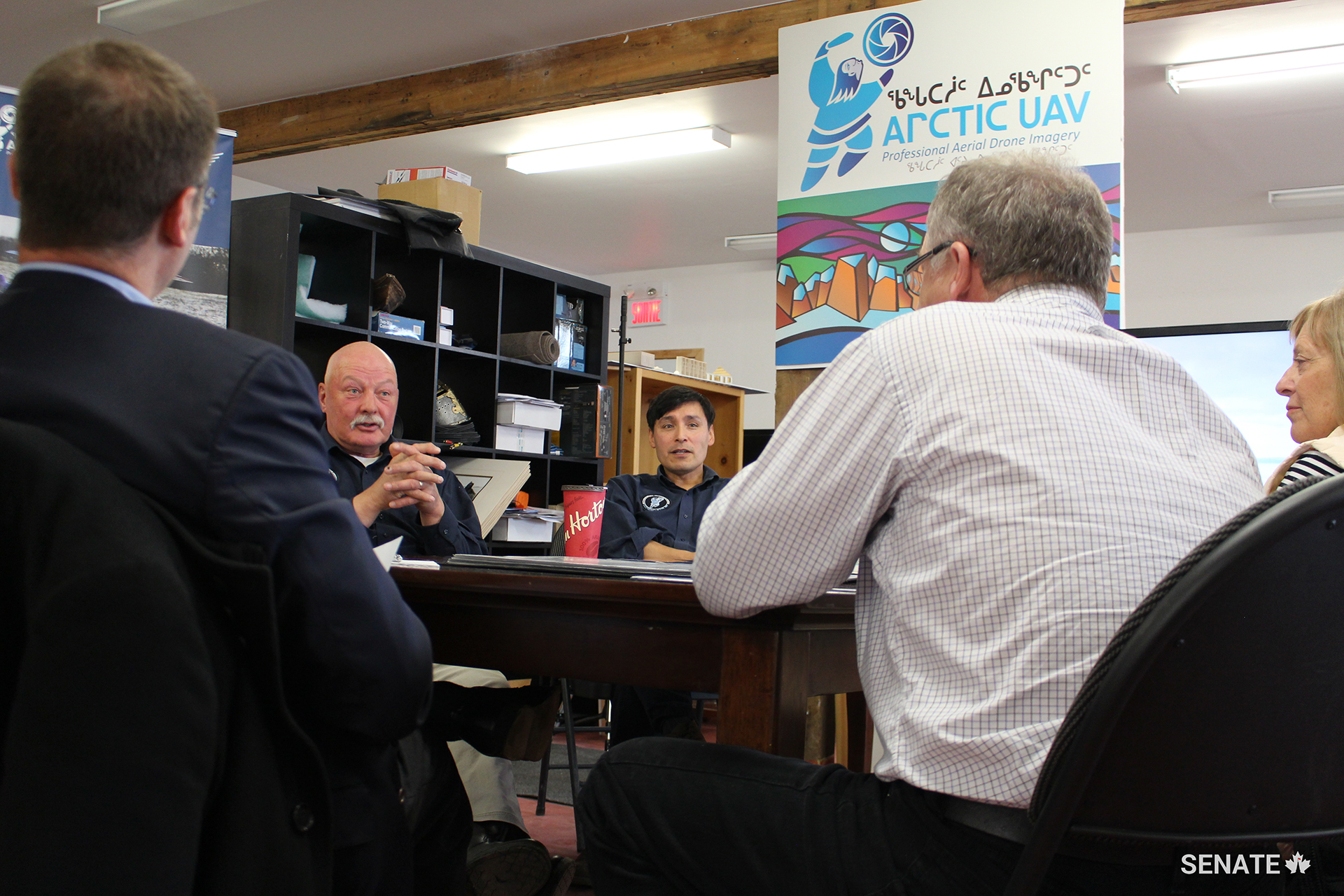 Arctic UAV chief operations officer Glenn Williams, left, tells senators how drones could greatly increase the efficiency of search and rescue operations in the North as chief executive officer Kirt Ejesiak looks on. Drones that rely on magnetic compasses fare poorly in close proximity to the magnetic north pole so the Iqaluit company uses two GPS devices on its aircraft to keep them oriented. The aircraft can also be outfitted with high-resolution cameras. Regulations, however, prevent pilots from flying drones outside of their line of sight — something Mr. Ejesiak is trying to change.
Arctic UAV chief operations officer Glenn Williams, left, tells senators how drones could greatly increase the efficiency of search and rescue operations in the North as chief executive officer Kirt Ejesiak looks on. Drones that rely on magnetic compasses fare poorly in close proximity to the magnetic north pole so the Iqaluit company uses two GPS devices on its aircraft to keep them oriented. The aircraft can also be outfitted with high-resolution cameras. Regulations, however, prevent pilots from flying drones outside of their line of sight — something Mr. Ejesiak is trying to change.
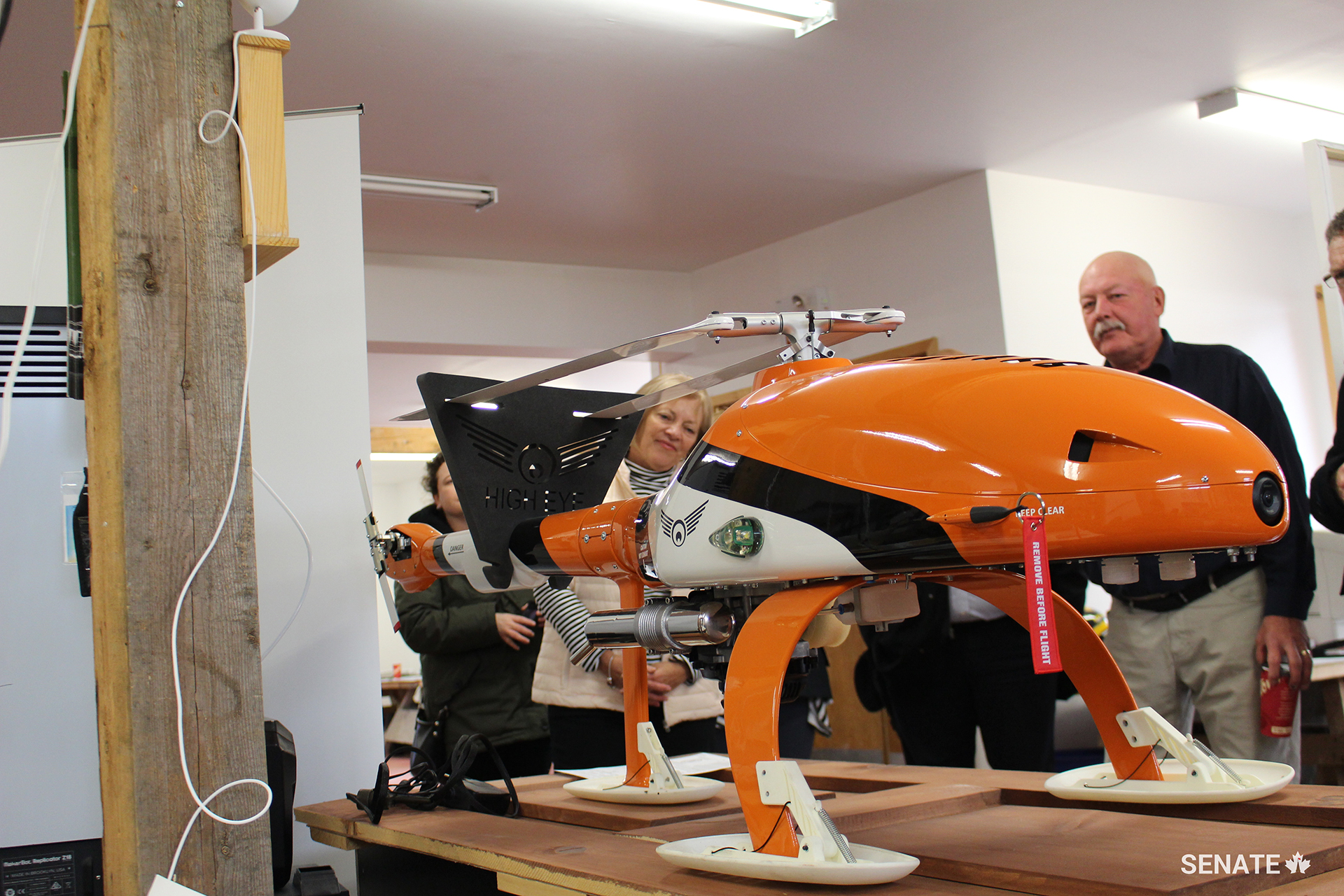 Senator Hartling and Mr. Williams examine one of Arctic UAV’s drones in the company’s Iqaluit workshop. The machines cost approximately $300,000. That may be too pricey for most people, but, for government, it is much cheaper than having to send military aviation assets to the North — the committee heard it costs approximately $12,000 an hour to operate a Hercules aircraft. Mr. Williams said the company also prides itself on training local drone pilots.
Senator Hartling and Mr. Williams examine one of Arctic UAV’s drones in the company’s Iqaluit workshop. The machines cost approximately $300,000. That may be too pricey for most people, but, for government, it is much cheaper than having to send military aviation assets to the North — the committee heard it costs approximately $12,000 an hour to operate a Hercules aircraft. Mr. Williams said the company also prides itself on training local drone pilots.

The next leg of the committee’s fact-finding mission took senators to Kuujjuaq, a village on the Koksoak River just south of Ungava Bay in the Nunavik region of northern Quebec. Accessible only by air or by water, Kuujjuaq is the sparsely populated region’s hub. About 90% of the population of Nunavik is Inuit.
Hunting and fishing is an important part of their way of life, but the committee heard locals are having to travel further and further afield in their search for food, increasing the likelihood that they will run into trouble and need to be rescued.

A fast rescue craft manoeuvers inside a breakwater at Kuujjuaq’s small harbour. The local government spent $3.5 million to provide a ship like this one to each of Nunavik’s 14 communities after a 2003 boating tragedy in Ungava Bay claimed the lives of four locals, including an 11-year-old girl.
The four people were in a canoe travelling from Kuujjuaq to Kangirsuk, about 230 kilometres away as the crow flies. When they didn’t arrive, local authorities began a search; the military was called in about two days later.
Growing mistrust between the locals and the military hampered rescue efforts, according to witness testimony and a report drafted after the operation concluded. Military and coast guard efforts focused on a region near where debris had been sighted; locals familiar with the currents in Ungava Bay believed the search should have been concentrated elsewhere.
 Senator Manning, centre, and Kativik Regional Government civil security co-ordinator Craig Lingard get ready to examine Kuujjuaq’s fast rescue craft. The boat is piloted by a trained team of Inuit; Mr. Lingard said this is one way in which local knowledge is put to use to improve the odds of a successful search. Regulations, however, prevent crews from travelling armed — which caused problems when rescuers ran into a bear during a mission. Locals are constantly frustrated by rules put in place by southern politicians and bureaucrats who don’t understand the different realities of the North, Mr. Lingard said.
Senator Manning, centre, and Kativik Regional Government civil security co-ordinator Craig Lingard get ready to examine Kuujjuaq’s fast rescue craft. The boat is piloted by a trained team of Inuit; Mr. Lingard said this is one way in which local knowledge is put to use to improve the odds of a successful search. Regulations, however, prevent crews from travelling armed — which caused problems when rescuers ran into a bear during a mission. Locals are constantly frustrated by rules put in place by southern politicians and bureaucrats who don’t understand the different realities of the North, Mr. Lingard said.
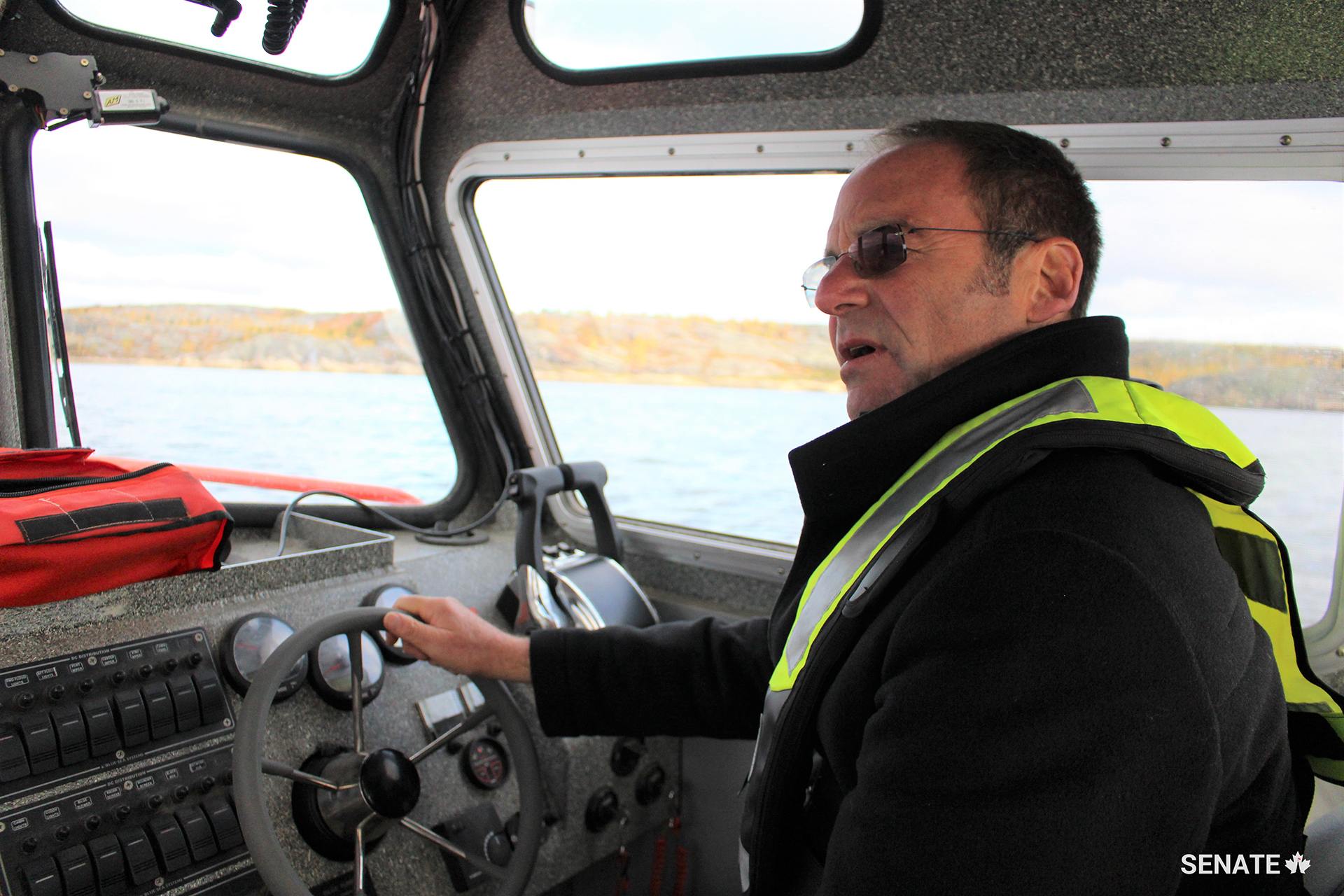 Senator Gold takes the wheel of Kuujjuaq’s fast rescue craft.
Senator Gold takes the wheel of Kuujjuaq’s fast rescue craft.
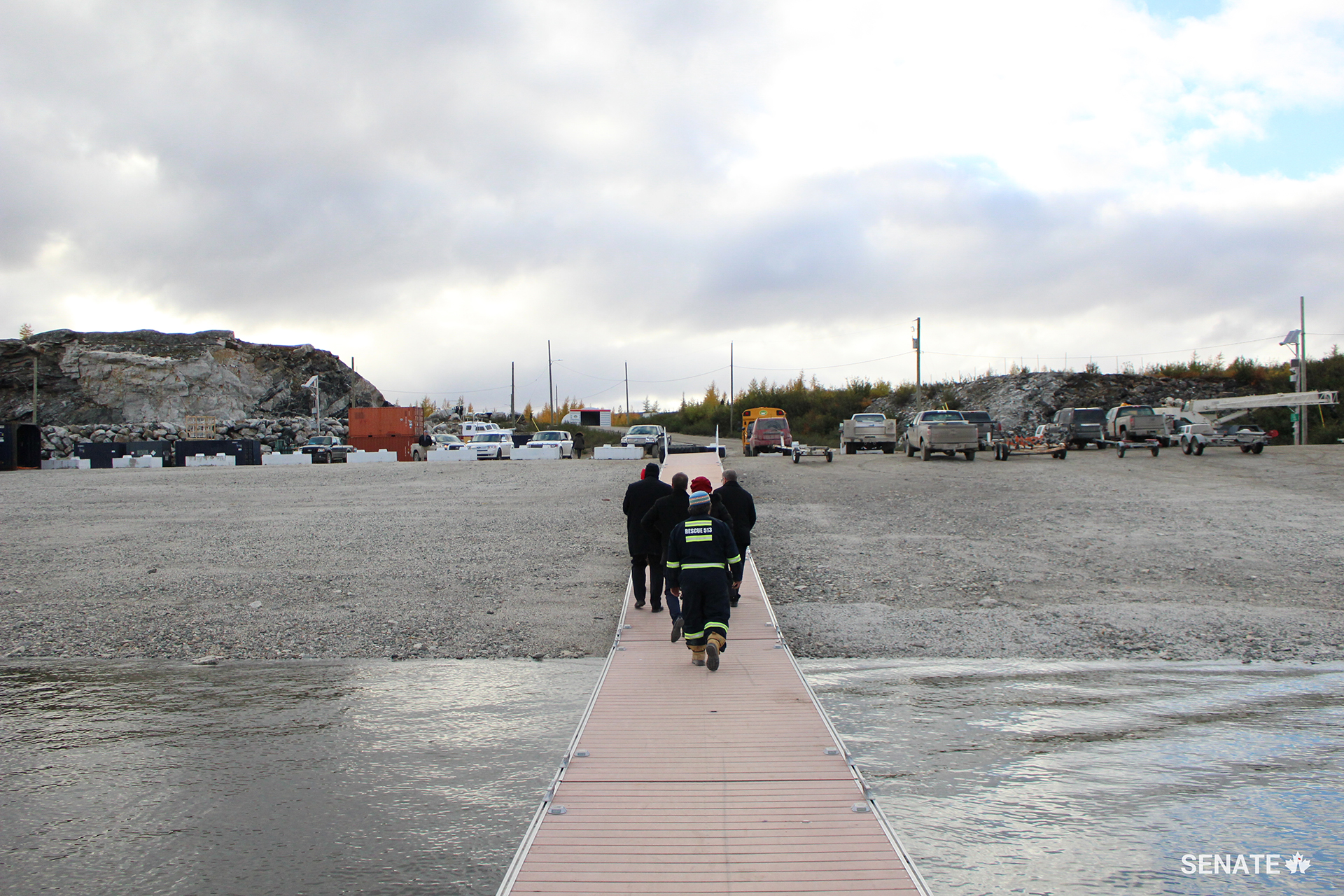 Senators return to dry land after a blustery trip on Kuujjuaq’s fast rescue craft. The committee expects to release its report on maritime search and rescue operations in Canada later in 2018.
Senators return to dry land after a blustery trip on Kuujjuaq’s fast rescue craft. The committee expects to release its report on maritime search and rescue operations in Canada later in 2018.
Related articles
Tags
Committee news
Local knowledge, volunteers fuel search and rescue operations in the North

Canada’s coastlines offer some of the world’s most difficult environmental conditions for maritime search and rescue operations. The unforgiving North presents unique challenges — the weather can be fierce and brutal, the Canadian Coast Guard has limited resources available to cover vast territory and military air assets must travel from bases in southern Ontario and the East Coast if they are called in to help.
But determined groups of locals — many of them volunteers — are coming up with innovative, made-in-the-North solutions to keep people safe.
Members of the Senate Committee on Fisheries and Oceans continued their in-depth study of maritime search and rescue operations with a fact-finding mission to Iqaluit, Nunavut and Kuujjuaq, Que. in October 2018. Here’s a glimpse of what they found.
 A small aircraft descends toward the airport in Iqaluit as the sun sets over Frobisher Bay. Air resources are difficult to come by in the North. Some Canadian Coast Guard icebreakers have light helicopters that can help with a search but not a rescue, and military resources are all based out of southern Canada, hours away.
A small aircraft descends toward the airport in Iqaluit as the sun sets over Frobisher Bay. Air resources are difficult to come by in the North. Some Canadian Coast Guard icebreakers have light helicopters that can help with a search but not a rescue, and military resources are all based out of southern Canada, hours away.
Michael Chappell, Zone Commander for the Civil Air Search and Rescue Association — a volunteer, non-profit group better known by its acronym, CASARA — told the committee his group builds relationships with private companies that have aircraft in the North so search operations can start more quickly.
 From right, committee chair Senator Fabian Manning, deputy chair Senator Marc Gold and Senator Nancy Hartling follow Louis Robert’s explanation of software used to monitor marine traffic in the Arctic at the Canadian Coast Guard’s Iqaluit communications facility. The coast guard is expecting a steady increase of marine traffic through the treacherous Northwest Passage as the North continues to warm.
From right, committee chair Senator Fabian Manning, deputy chair Senator Marc Gold and Senator Nancy Hartling follow Louis Robert’s explanation of software used to monitor marine traffic in the Arctic at the Canadian Coast Guard’s Iqaluit communications facility. The coast guard is expecting a steady increase of marine traffic through the treacherous Northwest Passage as the North continues to warm.
 Arctic UAV chief operations officer Glenn Williams, left, tells senators how drones could greatly increase the efficiency of search and rescue operations in the North as chief executive officer Kirt Ejesiak looks on. Drones that rely on magnetic compasses fare poorly in close proximity to the magnetic north pole so the Iqaluit company uses two GPS devices on its aircraft to keep them oriented. The aircraft can also be outfitted with high-resolution cameras. Regulations, however, prevent pilots from flying drones outside of their line of sight — something Mr. Ejesiak is trying to change.
Arctic UAV chief operations officer Glenn Williams, left, tells senators how drones could greatly increase the efficiency of search and rescue operations in the North as chief executive officer Kirt Ejesiak looks on. Drones that rely on magnetic compasses fare poorly in close proximity to the magnetic north pole so the Iqaluit company uses two GPS devices on its aircraft to keep them oriented. The aircraft can also be outfitted with high-resolution cameras. Regulations, however, prevent pilots from flying drones outside of their line of sight — something Mr. Ejesiak is trying to change.
 Senator Hartling and Mr. Williams examine one of Arctic UAV’s drones in the company’s Iqaluit workshop. The machines cost approximately $300,000. That may be too pricey for most people, but, for government, it is much cheaper than having to send military aviation assets to the North — the committee heard it costs approximately $12,000 an hour to operate a Hercules aircraft. Mr. Williams said the company also prides itself on training local drone pilots.
Senator Hartling and Mr. Williams examine one of Arctic UAV’s drones in the company’s Iqaluit workshop. The machines cost approximately $300,000. That may be too pricey for most people, but, for government, it is much cheaper than having to send military aviation assets to the North — the committee heard it costs approximately $12,000 an hour to operate a Hercules aircraft. Mr. Williams said the company also prides itself on training local drone pilots.

The next leg of the committee’s fact-finding mission took senators to Kuujjuaq, a village on the Koksoak River just south of Ungava Bay in the Nunavik region of northern Quebec. Accessible only by air or by water, Kuujjuaq is the sparsely populated region’s hub. About 90% of the population of Nunavik is Inuit.
Hunting and fishing is an important part of their way of life, but the committee heard locals are having to travel further and further afield in their search for food, increasing the likelihood that they will run into trouble and need to be rescued.

A fast rescue craft manoeuvers inside a breakwater at Kuujjuaq’s small harbour. The local government spent $3.5 million to provide a ship like this one to each of Nunavik’s 14 communities after a 2003 boating tragedy in Ungava Bay claimed the lives of four locals, including an 11-year-old girl.
The four people were in a canoe travelling from Kuujjuaq to Kangirsuk, about 230 kilometres away as the crow flies. When they didn’t arrive, local authorities began a search; the military was called in about two days later.
Growing mistrust between the locals and the military hampered rescue efforts, according to witness testimony and a report drafted after the operation concluded. Military and coast guard efforts focused on a region near where debris had been sighted; locals familiar with the currents in Ungava Bay believed the search should have been concentrated elsewhere.
 Senator Manning, centre, and Kativik Regional Government civil security co-ordinator Craig Lingard get ready to examine Kuujjuaq’s fast rescue craft. The boat is piloted by a trained team of Inuit; Mr. Lingard said this is one way in which local knowledge is put to use to improve the odds of a successful search. Regulations, however, prevent crews from travelling armed — which caused problems when rescuers ran into a bear during a mission. Locals are constantly frustrated by rules put in place by southern politicians and bureaucrats who don’t understand the different realities of the North, Mr. Lingard said.
Senator Manning, centre, and Kativik Regional Government civil security co-ordinator Craig Lingard get ready to examine Kuujjuaq’s fast rescue craft. The boat is piloted by a trained team of Inuit; Mr. Lingard said this is one way in which local knowledge is put to use to improve the odds of a successful search. Regulations, however, prevent crews from travelling armed — which caused problems when rescuers ran into a bear during a mission. Locals are constantly frustrated by rules put in place by southern politicians and bureaucrats who don’t understand the different realities of the North, Mr. Lingard said.
 Senator Gold takes the wheel of Kuujjuaq’s fast rescue craft.
Senator Gold takes the wheel of Kuujjuaq’s fast rescue craft.
 Senators return to dry land after a blustery trip on Kuujjuaq’s fast rescue craft. The committee expects to release its report on maritime search and rescue operations in Canada later in 2018.
Senators return to dry land after a blustery trip on Kuujjuaq’s fast rescue craft. The committee expects to release its report on maritime search and rescue operations in Canada later in 2018.


